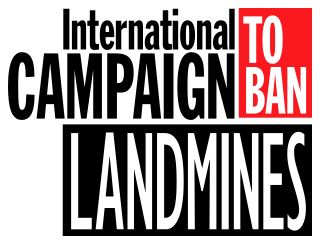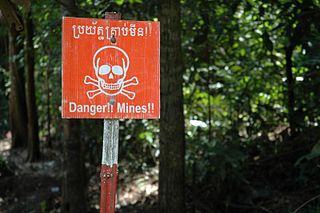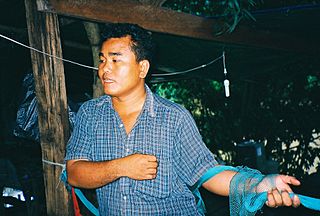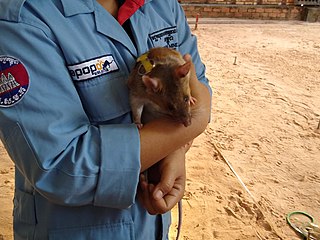
The International Campaign to Ban Landmines (ICBL) is a coalition of non-governmental organizations whose stated objective is a world free of anti-personnel mines and cluster munitions, where mine and cluster munitions survivors see their rights respected and can lead fulfilling lives.

The HALO Trust is a non-political and non-religious registered British charity and American non-profit organization which removes debris left behind by war, in particular land mines. With over 8,000 deminers worldwide, HALO has operations in 28 countries. Its largest operation is in Afghanistan, where the organization continues to operate under the Taliban regime that took power in August 2021.

Unexploded ordnance, unexploded bombs (UXBs), and explosive remnants of war are explosive weapons that did not explode when they were employed and still pose a risk of detonation, sometimes many decades after they were used or discarded. UXO does not always originate from wars; areas such as military training grounds can also hold significant numbers, even after the area has been abandoned. UXO from World War I continue to be a hazard, with poisonous gas filled munitions still a problem. When unwanted munitions are found, they are sometimes destroyed in controlled explosions, but accidental detonation of even very old explosives also occurs, sometimes with fatal results.

Demining or mine clearance is the process of removing land mines from an area. In military operations, the object is to rapidly clear a path through a minefield, and this is often done with devices such as mine plows and blast waves. By contrast, the goal of humanitarian demining is to remove all of the landmines to a given depth and make the land safe for human use. Specially trained dogs are also used to narrow down the search and verify that an area is cleared. Mechanical devices such as flails and excavators are sometimes used to clear mines.

Cambodia is a country located in Southeast Asia that has a major problem with landmines, especially in rural areas. This is the legacy of three decades of war which has taken a severe toll on the Cambodians; it has some 40,000 amputees, which is one of the highest rates in the world. The Cambodian Mine Action Centre (CMAC) estimates that there may be as many as four to six million mines and other pieces of unexploded ordnance in Cambodia. Some estimates, however, run as high as ten million mines.

Minefields in Croatia cover 258.00 square kilometres of territory. As of 2020, the minefields are located in 45 cities and municipalities within 8 counties. These areas are thought to contain approximately 17,285 land mines, in addition to unexploded ordnance left over from the Croatian War of Independence. Land mines were used extensively during the war by all sides in the conflict; about 1.5 million were deployed. They were intended to strengthen defensive positions lacking sufficient weapons or manpower, but played a limited role in the fighting.
A mine clearance organization, or demining organization, is an organization involved in removal of landmines and unexploded ordnance (UXO) for military, humanitarian, or commercial reasons. Demining includes mine clearance, as well as surveying, mapping and marking of hazardous areas.

The region of Nagorno-Karabakh and areas around it are considered to be some of the most heavily mined regions of the former Soviet Union. Mines were laid from early 1990s by both Azerbaijani and Armenian forces during and after the First Nagorno-Karabakh War. The worst-affected areas are along the fortified former contact line between Azerbaijani and Armenian forces, in particular in the districts of Aghdam, Fuzuli and Jabrayil. According to military experts from both Azerbaijan and Armenia, the ground in those areas is covered with "carpets of land mines."

Aki Ra is a former Khmer Rouge conscripted child soldier who works as a deminer and museum curator in Siem Reap, Cambodia. He has devoted his life to removing landmines in Cambodia and to caring for young landmine victims. Aki Ra states that since 1992 he has personally removed and destroyed as many as 50,000 landmines, and is the founder of the Cambodian Landmine Museum.
Mine action is a combination of humanitarian aid and development studies that aims to remove landmines and reduce the social, economic and environmental impact of them and the explosive remnants of war (ERW).

The Mines Advisory Group (MAG) is a non-governmental organization that assists people affected by landmines, unexploded ordnance, and small arms and light weapons.

APOPO is a registered Belgian non-governmental organisation and US non-profit which trains southern giant pouched rats to detect landmines and tuberculosis. They call their trained rats 'HeroRATs'.

The United Nations Mine Action Service (UNMAS) is a service located within the United Nations Department of Peacekeeping Operations that specializes in coordinating and implementing activities to limit the threat posed by mines, explosive remnants of war and improvised explosive devices.
Golden West Humanitarian Foundation is an American Non-profit (501C3) organisation that develops technology to address the technical limitations of humanitarian mine clearance. The Golden West Humanitarian Foundation is based in Woodland Hills, Los Angeles, California.

Danish Demining Group (DDG) is the Human Security Unit under the Danish Refugee Council (DRC), specialised in clearing landmines and unexploded ordnance and reducing armed violence.

The Center for International Stabilization and Recovery (CISR), formerly the Mine Action Information Center (MAIC), is a public policy center at James Madison University that manages information, conducts training, holds conferences and workshops, and performs research relevant to humanitarian mine clearance, victim assistance, mine risk reduction and other explosive remnants of war (ERW).

The Cambodian Landmine Museum and Relief Facility is a museum located in Cambodia, south of the Banteay Srey Temple complex, 25 kilometers north of Siem Reap, and inside the Angkor National Park.
Gender mainstreaming in mine action is the application of gender mainstreaming to mine action. It is increasingly being adopted by international and state mine action organizations.
Legacies of War, is a fiscally sponsored project of NEO Philanthropy, Inc (NEO), dedicated to raising awareness about the history of the Vietnam War-era bombing in Laos and advocate for the clearance of unexploded bombs, (UXO) and survivor assistance, to provide space for healing the wounds of war, and to create greater hope for a future of peace.

Approximately 30,000 land mines were laid in the British overseas territory of the Falkland Islands by Argentinian forces following their 1982 invasion. Some of the mines were cleared immediately following the successful British operation to retake the islands but following a series of accidents demining operations ceased. In the following years the mine fields were fenced off and, with human access limited, became havens for Falklands flora and the native penguin population. The British government ratified the Ottawa Treaty in 1998 that required the removal of all mines within its territory. Demining operations, which had to be carried out by hand due to the climate and local condition, restarted in 2009. The last mines were cleared in October 2020.














